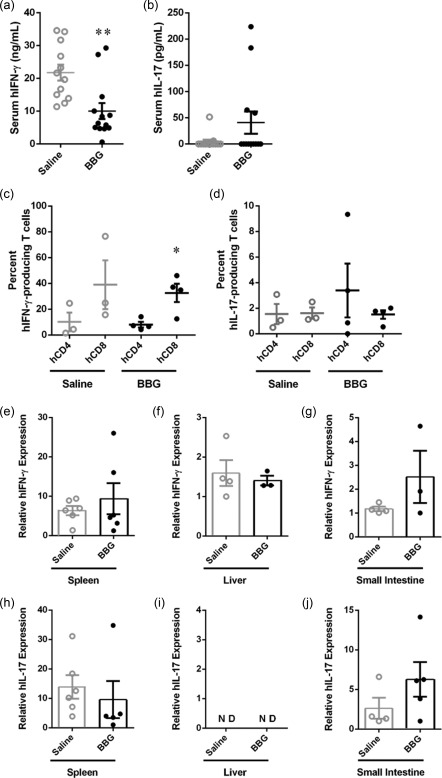Figure 8.

Brilliant Blue G (BBG) reduces serum human interferon (IFN)‐γ significantly in humanized mice. (a–j) Non‐obese diabetic‐severe combined immunodeficiency‐interleukin (NOD‐SCID‐IL)‐2Rγnull (NSG) mice were injected intraperitoneally (i.p.) with 10 × 106 human (h) peripheral blood mononuclear cells (PBMCs) (day 0) and with saline (control) or 50 mg/kg Brilliant Blue G (BBG) (from Fig. 5). Concentrations of serum (a) hIFN‐γ, and (b) hIL‐17 were analysed by enzyme‐linked immunosorbent assay (ELISA). Data represents group mean ± standard error of the mean (s.e.m.) (saline n = 12, BBG n = 13); **P < 0·005 compared to saline‐injected mice. (c,d) Splenocytes were incubated in complete RPMI‐1640 medium containing phorbol 12‐myristate 13‐acetate and ionomycin for 4 h, and the percentage of hCD4+ and hCD8+ T cells producing intracellular (c) hIFN‐γ or (d) hIL‐17 was determined by flow cytometry. Data represents group mean ± s.e.m. (saline n = 3, BBG = 4); symbols represent individual mice; *P < 0·05 compared to corresponding hCD4+ T cells. (e–j) The relative expression of (e–g) hIFN‐γ and (h–j) hIL‐17 in (e,h) spleen, (f,i) liver and (g,j) small intestine from mice at end‐point were examined by quantitative polymerase chain reaction (qPCR). Data represents group means ± s.e.m. (n = 2–6); symbols represent individual mice; n.d. = not detected.
